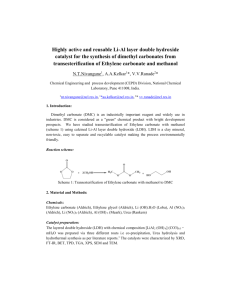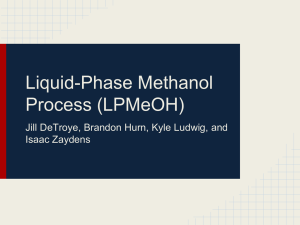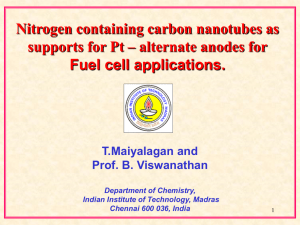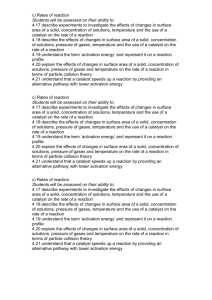Progress of Fine Sulfur-Removal Technology on Nitrogen Fe
advertisement
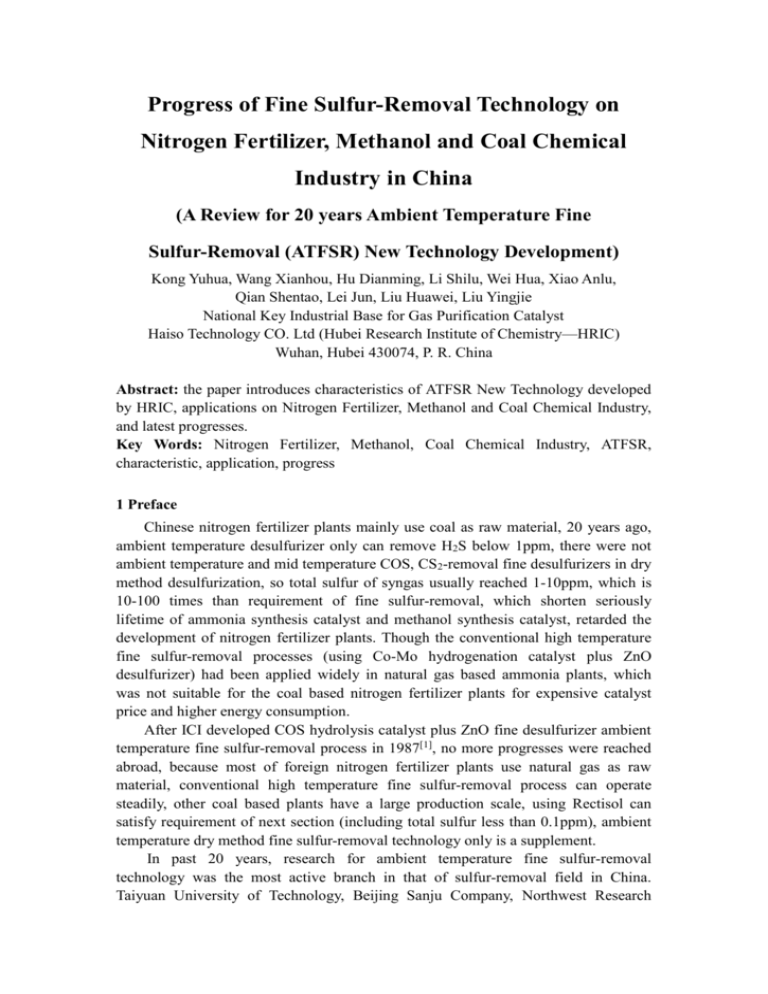
Progress of Fine Sulfur-Removal Technology on Nitrogen Fertilizer, Methanol and Coal Chemical Industry in China (A Review for 20 years Ambient Temperature Fine Sulfur-Removal (ATFSR) New Technology Development) Kong Yuhua, Wang Xianhou, Hu Dianming, Li Shilu, Wei Hua, Xiao Anlu, Qian Shentao, Lei Jun, Liu Huawei, Liu Yingjie National Key Industrial Base for Gas Purification Catalyst Haiso Technology CO. Ltd (Hubei Research Institute of Chemistry—HRIC) Wuhan, Hubei 430074, P. R. China Abstract: the paper introduces characteristics of ATFSR New Technology developed by HRIC, applications on Nitrogen Fertilizer, Methanol and Coal Chemical Industry, and latest progresses. Key Words: Nitrogen Fertilizer, Methanol, Coal Chemical Industry, ATFSR, characteristic, application, progress 1 Preface Chinese nitrogen fertilizer plants mainly use coal as raw material, 20 years ago, ambient temperature desulfurizer only can remove H2S below 1ppm, there were not ambient temperature and mid temperature COS, CS2-removal fine desulfurizers in dry method desulfurization, so total sulfur of syngas usually reached 1-10ppm, which is 10-100 times than requirement of fine sulfur-removal, which shorten seriously lifetime of ammonia synthesis catalyst and methanol synthesis catalyst, retarded the development of nitrogen fertilizer plants. Though the conventional high temperature fine sulfur-removal processes (using Co-Mo hydrogenation catalyst plus ZnO desulfurizer) had been applied widely in natural gas based ammonia plants, which was not suitable for the coal based nitrogen fertilizer plants for expensive catalyst price and higher energy consumption. After ICI developed COS hydrolysis catalyst plus ZnO fine desulfurizer ambient temperature fine sulfur-removal process in 1987[1], no more progresses were reached abroad, because most of foreign nitrogen fertilizer plants use natural gas as raw material, conventional high temperature fine sulfur-removal process can operate steadily, other coal based plants have a large production scale, using Rectisol can satisfy requirement of next section (including total sulfur less than 0.1ppm), ambient temperature dry method fine sulfur-removal technology only is a supplement. In past 20 years, research for ambient temperature fine sulfur-removal technology was the most active branch in that of sulfur-removal field in China. Taiyuan University of Technology, Beijing Sanju Company, Northwest Research Institute of Chemical Industry and Kunshan Research Institute of Fine Chemical Industry have done many works, our center developed COS hydrolysis catalyst plus active carbon fine desulfurizer ambient temperature fine sulfur-removal process, and which was applied firstly in1991, then developed a set of integrated Ambient Temperature Fine Sulfur-Removal (hereinafter called “ATFSR”) New Technology[2] which contains JTL-1, JTL-4 and JTL-5 as hard core. The new technology can solve various problems of fine desulfurization in feed gas using coal or oil as raw material (total sulfur (H2S+COS+CS2)<0.1ppm), which has gotten 26 Chinese patents, and has been applied in more than 2000 devices (times). In October 1999 and 2000, conferred by the State Science and Technology Ministry, our center representing Chinese Government has successfully hold the first and second international training workshop of ATFSR New Technology, five papers have been presented in International Nitrogen Conference[3], eight products have been exported to USA, UK, Australia, etc., the paper introduces characteristics of ATFSR New Technology developed by HRIC, applications on nitrogen fertilizer, methanol and coal chemical industry, and latest progresses. 2 Main affairs of ATFSR New Technology during 20 years’ development (1) In 1989, according to the desire of Nitrogen Fertilizer Center of Former Chemical Industry Ministry, our center began to formally develop ambient temperature COS hydrolysis catalyst. (2) In 1991, JTL-1 New Process, composed by EH-1Q COS hydrolysis catalyst and EAC-1 special active carbon fine desulfurizer, was applied firstly in Hunan Yiyang Nitrogen Fertilizer Plant to protect methanol synthesis catalyst. (3) In 1993, JTL-1 New Process was undergone expert examinations organized by Former Chemical Industry Ministry and Hubei Province Science and Technology Commission, EH-1Q and EAC-1 were denominated as T504 COS Hydrolysis Catalyst and T101 Active Carbon Fine Desulfurizer respectively by central department chemical fertilizer catalysts standardization, which indicated ATFSR New Technology got a great breakthrough. (4) In 1994, T504 COS Hydrolysis Catalyst, T101 Active Carbon Fine Desulfurizer and JTL-1 New Process won the first Scientific Development Award from Hubei Science & Technology Progress, JTL-1 New Process won Chinese Patent. (5) In 1996, JTL-1, JTL-4 and JTL-5 New Processes was applied firstly in Shijiazhuang Baoshi Electronic Glass Company to replace Japan technology, won a Chinese Patent, the second Scientific Development Award from Electronics Industry Ministry Science & Technology Progress. (6) During 1995.8-1999.4, lifetime of methanol synthesis catalyst of Shandong Tancheng Nitrogen Fertilizer Plant reached 3 years and 8 months after using JTL-4 New Process, which is a great breakthrough for Combined Ammonia-Methanol Process developed uniquely in China. (7) During 1995-1998, EH-2 Mid Temperature Sulfur-Tolerant Hydrolysis Catalyst plus JTL-1 New Process was applied in first batch coal based Methanol plant using low-pressure methanol synthesis process, lifetime of methanol synthesis catalyst reached 3.1 years, the methanol output per cubic meter catalyst reached 14000 tons. (8) In 1998, JTL-1, JTL-4, JTL-5 New Processes were listed in Top Ten High New Technologies Extension of China Nitrogen Fertilizer Industry Association. (9) 1999, “National Key Industrial Base for CO Water Gas Shift Catalyst and Gas Purification Catalyst” supported by our institute, constructed by National Development and Reform Commission passed the acceptance check, which indicated that our center begin to charge with heavy responsibilities of development and production for CO water gas shift catalyst and gas purification catalyst. (10) In 2000, JTL-4 and JTL-5 New Processes were undergone expert examinations organized by Former Chemical Industry Ministry and Hubei Province Science and Technology Commission. (11) In 1999 and 2000, our center representing Chinese Government successfully held the first and second international training workshop of ATFSR New Technology. (12) In 1999 and 2001, Kong Yuhua twice attended International Nitrogen Conference, and presented three papers in conference. (13) During 1999-2002, T504 COS Hydrolysis Catalyst, EAC-6 RSH-Removal Fine Desulfurizer, etc. six products were tested by foreign famous company, most of performances is similar with competitive samples, two of they had 1-2 times higher sulfur capacity than competitive samples, the six products were exported to USA and UK. (14) In 2000, Urea Dehydrogen New Technology, composed by ATFSR New Technology and Dehydrogen catalyst, was applied firstly in Shanghai Wujing Chemical Plant. (15) In 2003, Food Grade CO2 Production New Technology, composed by ATFSR New Technology, THC-1 Hydrocarbon-Removal Catalyst and high quality tower inner parts, was applied firstly in Liuzhou Chemical Plant. (16) In 2004, Hydrolysis Guard New Technology was applied firstly in high CO feed gas of Yantai Wanhua MDI Plant. (17) During 1998-2002, ATFSR New Technology was applied in Jiangsu Suopu and Danyang coal based acetic acid synthesis plants. (18) In Feb. 2008, Deep Purification New Technology especially for large-medium methanol plant and coal-to-oil plant, outlet total sulfur (H2S + COS) less than 10ppb, was applied firstly in Baoji 10000 ton-class coal-to-oil plant of Shanxi Jinchao Investment Corporation, which was undergone expert examination organized by South Africa in Oct. 2008. (19) In 2008, Hydrolysis Guard New Technology and ATFSR New Technology were applied in domestic most yellow phosphorus tailor gas treatment of Chuantou Group. (20) In 2008, a set of purification technologies, composed by Hydrolysis Guard New Technology, ATFSR New Technology, Cl-removal and O2-removal technology, were applied firstly in Henan Shunda acetic acid synthesis plant. (21) In 2009, lifetime of methanol synthesis catalyst of Shandong Jiutai Chemical Plant reached 5 years, lifetime of methanol synthesis catalyst of Shandong Lunan Chemical Plant reached 4 years (at present, hotspot temperature is 238 degree C, only 10 degree C was increased during 4 years usage, so estimated lifetime can reach 5-6 years.), the methanol output per cubic meter catalyst had reached 27000 tons, the two plants both established the new record in two key indicators of methanol plant. 3 Characteristics of ATFSR New Technology (1) ATFSR New Technology, composed by tens of fine desulfurizers and JTL-1, JTL-4 and JTL-5 New Processes, can solve various problems of fine desulfurization in feed gas using coal or oil as raw material. (2) ATFSR New Technology can ensure total sulfur (H2S+COS+CS2) of feed gas or syngas, total sulfur (H2S+RSH+RSSR) of natural gas less than 0.1ppm, the desulfurization precision is high (less than 0.03ppm), HC-2 and HC-3 Trace Sulfur Analyzers examined by State Standard Substance Research Center can determine various sulfides, with high sensitivity, good stability, rapid and convenient operation. (3) ATFSR New Technology has independent intellectual property. Eight products have been exported to USA, UK, Australia, etc., which has reached international advanced level on the whole, with prominent innovation. (4) ATFSR New Technology has been applied in more than 2000 desulfurization devices (times), such as methanol, ammonia, urea, food CO2, fine chemical industry (DMF, HAC, TDI, MDI, etc.), petrochemical industry, natural gas chemical industry, electronics and environment protection, economic and social benefit are very obvious. (5) On the basis of ATFSR new technology, we also developed Urea Dehydrogen, Food Grade CO2 Purification, Hydrolysis Guard, Deep Purification, Multi-Functions Purification and a set of purification technology of acetic acid synthesis. 4 Industrial Application of ATFSR New Technology 4.1 Protection of Methanol Synthesis Catalyst In China, low-pressure methanol synthesis process has been used since 1996, thereinto the data for lifetime of methanol synthesis catalyst and methanol production intensity are show in Table 1. Table 1 effect of ATFSR in protecting Methanol Synthesis Catalyst Production Capacity, fine Usage Lifetime, Plants intensity, t t/year desulfurization from month methanol/m3 cat. Henan Anyang EH-2 plus 30,000 1996 24 6621 【4】 Chemical Plant JTL-1 No.2 Chemical EH-2 plus Plant of Hubei 30,000 1996 26 6200 JTL-1 Jingmen Shandong Lunan EH-2 plus 100,000 2000 37 14000 【5】 Chemical Plant JTL-1 Shandong Jiutai EH-2 plus 80,000 2003 60 16837 【6】 Chemical Plant JTL-1 Shandong Lunan Chemical Plant【7】 100,000 EH-2 plus JTL-1 2005 >48*2 27000 Large Co-Mo plus scale, 1995 60 35000 ZnO NG based *1 Note: quote from paper of 2001 International Nitrogen Conference; *2 at present, hotspot temperature is 238 degree C, only 10 degree C was increased during 4 years usage, so estimated lifetime can reach 5-6 years. The data of Table 1 shows that, in foreign typical methanol plant, lifetime of methanol synthesis catalyst reached 5 years, methanol output per cubic meter catalyst reached 35000 tons, in China, from the first application of low-pressure methanol synthesis process in Henan Anyang Chemical Plant to now, the latest application data shows we will reach the level of foreign typical NG based methanol plant. 4.2 Protection of methanation catalyst and ammonia synthesis catalyst Cuprammonia Wash system has been eliminated for 50-60 years abroad, which did not operate steadily, resulting in serious contamination of Cu2+ ion for ground water, some medium-small nitrogen fertilizer plants had to use it for non ATFSR New Technology in the past. The data of Table 2 shows lifetime of methanation catalyst reached eight years after using ATFSR New Technology downstream of carbonating tower, which approach the level of large-scale plant (ten years). Lifetime of ammonia synthesis catalyst have reached ten years in large-scale nitrogen fertilizer plant, after using ATFSR New Technology, lifetime of ammonia synthesis catalyst was prolonged manifold in medium-small nitrogen fertilizer plants, we did not do extensive survey, only know that lifetime of ammonia synthesis catalyst of Shandong Tancheng nitrogen fertilizer plant has reached seven years (see data from Table 2). Methanol-- methanation process developed by Hunan Anchun Company is a big improvement for coal based medium-small nitrogen fertilizer plants, combined with ATFSR New Technology, which improved level of gas purification, now lifetime of single tower methanol synthesis catalyst reaches 3-4 years, lifetime of methanation catalyst (carbonating-- methanation process) reaches 8 years, we can expect, with elimination of Cuprammonia Wash system, lifetime of methanation catalyst and ammonia synthesis catalyst will reach or exceed ten years. Table 2 effect of ATFSR in protecting methanation catalyst and ammonia synthesis catalyst lifetime of Ammonia lifetime of fine ammonia Plants capacity, methanation cat., desulfurization synthesis cat., t/year years years Yunan Dongfeng Carbonating + nitrogen fertilizer 60,000 8 / JTL-1 plant Hebei Zhengding 5 (still active, 60,000 JTL-1 / nitrogen fertilizer discharge for foreign typical methanol plant*1 plant replacing equipment) Shandong Tancheng JTL-1 + nitrogen fertilizer 60,000 Cuprammonia / 7 plant Wash 4.3 Protection of urea dehydrogen catalyst, urea dehydrogen new technology After urea dehydrogen new technology, composed by ATFSR new technology + TH-2/TH-3 H2-removal catalyst + HC-2 Trace Sulfur Analyzer, was introduced in China small nitrogen fertilizer technical exchange meeting, macroscopical situation had following change: (1) Government attached great importance to safety production. (2) In 2005, fatal explosion took place in urea synthesis tower of a certain plant. No definite conclusion was given yet on explosion reason, however chemical experts thought that the reason of H2 and O2 accumulation of tail gas of urea synthesis tower did not be eliminated, after investigating, a certain expert said, the type of explosion ever took place in every part of urea synthesis system, especially 10 times fatal explosions. (3) In the past, someone thought there was not explosion (H2 react with O2) danger after using ammonia stripping process, so dehydrogen is not necessary. Recently a foreign expert of urea technology thought, when exchange in our center, the NH3-H2-O2 gas operational diagram shows using ammonia stripping process can reduce probability of explosion, however can not avoid, in fact dehydrogen device was added in some plants using ammonia stripping process, so aforementioned standpoint is incorrect, the international community has acknowledged that urea dehydrogen catalyst (noble metal) is the most effective way to avoid explosion for H2 and O2 accumulation. In recent years, relative technologies had progresses as below: (1) Lifetime of TH-2 urea dehydrogen catalyst reached six years first time in Sichuan Meifeng Chemical Plant (natural gas based, total sulfur <0.1ppm in CO2 feed gas), this is a big progress. (2) Coal based medium-small nitrogen fertilizer plants place more emphasis on desulfurization, the process “semi-water-gas desulfurization”—“shift gas desulfurization”—“fine desulfurization” was installed widely, because of “shift gas desulfurization”, fine desulfurization load of CO2 feed gas in urea system has been reduced, to ensure urea dehydrogen new technology can be extended widely. (3) The progress of urea dehydrogen technology. The application of reaction heat of dehydrogenation recovery technology and medium pressure urea dehydrogen technology can reduce markedly operational expense of dehydrogen system. (4) Our catalyst regeneration patent (Ambient Temperature Regeneration Process of H2-Removal Catalyst. NO.ZL200510018579.6) technology has been applied several times in TH-3 Dehydrogen Catalyst regeneration of Zhenhai Refiner, some catalyst has been regenerated twice, total sulfur is 0.5-2ppm of feed gas in the plant, so lifetime of TH-3 catalyst only 1-2 years, after be regenerated, lifetime of TH-3 regenerated reached nine months (expectant lifetime is six months). In recent years, the new technology has been applied more than 30 devices (times), market share reached approx. 70%, lifetime of Dehydrogen Catalyst in coal based plant can reach 2-3 years (i.e. Dezhou Chemical Plant, Jiangsu Huachang Chemical Plant, etc.), while obvious economic benefit was got: ammonia consumption was saved 1.5-2kg/t urea, the corrosion of equipment for trace sulfide was avoided. 5 other new technologies developed after ATFSR New Technology applied in other coal chemical industries 5.1 Food Grade CO2 Production New Technology【8】 Food grade CO2 is used widely in the beverage industry, tobacco swelling, supercritical extraction, etc. In recent years, the demand for food grade CO2 gas has increase rapidly. There are 20 items specified of International Society of Beverage Technologists (ISBT), which is very stringent. Of these 20 items, the most severe are: (1) Total sulfur ≤0.1 ppm (2) Benzene content ≤20 ppb (3) Total hydrocarbon content (as CH4) ≤50ppm (of which CH4 ≤30 ppm) Food Grade CO2 Production New Technology, composed by JTL-1 Fine-Removal New Process developed by our center plus Food Grade CO2 Hydrocarbon-Removal New Technology, developed by Hangzhou Kuaikai Company and our center, has been applied successfully in Liuzhou Chemical Plant first time in 2003, as determined by China National Standard Substance Research Center, the finished product CO2 totally satisfies all 20 items of the ISBT standard and the product has been approved by Coca Cola (China) Company and the Pepsi-Cola Company. 5.2 Hydrolysis Guard New Technology for high CO, high COS condition【9】 In 2004, Hydrolysis Guard New Technology has applied firstly in Shandong Yantai Wanhua MDI plant, the new technology plus wet desulfurization can solve COS removal in high CO, high COS condition, have following characteristics: (1) good sulfur removal effect: outlet H2S and COS less than 0.01%. (2) low operational temperature: 50-70 degree C. (3) long lifetime: more than 12 months, which is 3-4 times of ordinary hydrolysis catalyst plus ferric oxide fine desulfurizer, reduce loss for start up and shut down. (4) Low operational expenses: total expenses of Hydrolysis Guard New Technology plus wet desulfurization are RMB 0.07/m3, which only half of that of one-step desulfurization, 40% of that of ordinary hydrolysis catalyst plus ferric oxide fine desulfurizer. (5) Good high COS-tolerant capacity: when inlet COS reached 0.5%, outlet COS and H2S still less than 0.01%. At present, the new technology has been applied in other fine chemical industry field. 5.3 Multi-Functions Purification New Technology【10】 DJ-1 Multi-Functions Purificant has been applied in water gas based methanol device of Guizhou Shuijing Chemical Plant, in November 2007, inlet and outlet COS, CS2, O2 contents were determined, the data see Table 3 and 4. Table 3 organic sulfide data of DJ-1 Inlet Hot-spot Inlet, Outlet, Percent Date Sulfide 3 3 Temp., ℃ temp., ℃ mgS/m mgS/m conversion COS 660 18 97.3% Nov. 11 172 198 CS2 19 0.15 99.2% COS 520 17 96.7% Nov. 12 170 200 CS2 18 0.1 99.4% Note: COS and CS2 content was determined by HC-2 Trace Sulfur Analyzer. Table 4 O2 data of DJ-1 Inlet O2 Outlet O2 in Outlet O2 in Rate of O2 Date content, ppm tower A, ppm tower B, ppm removal, % Nov. 11 350 3.5 3.3 99.0 Nov. 12 328 4.6 6.2 98.6 Note: O2 content was determined by CW2000 Trace Oxygen Analyzer on line. 5.4 Deep Purification New Technology especially for large-medium methanol plant and coal-to-oil plant【11】 Coal chemical industry had been developing quickly from several years ago, especially large-scale methanol and coal-to-oil device were successively developed, taking a 1×106 t methanol/year plant for instance, total expenses of replacing one time catalyst and one time overhaul exceed 1×108 RMB, so it is urgent to prolong lifetime of methanol synthesis catalyst from 2-3 years to 5-6 years, so as to guarantee to change methanol synthesis catalyst once only every two times overhaul, so we developed Deep Purification New Technology, which can remove total sulfur (Ts, H2S + COS) <10ppb, Fe(CO)5 + Ni(CO)4 to <20ppb, prolong the lifetime of methanol synthesis catalyst and the lifetime of F-T synthesis catalyst manifold, so as to guarantee to change methanol synthesis catalyst once only every two times overhaul, economic benefit is very obvious. In Feb. 2008, The new technology was applied firstly in Baoji 10000 ton-class coal-to-oil plant of Shanxi Jinchao Investment Corporation, outlet total sulfur (H2S + COS) less than 10ppb, activity of F-T synthesis catalyst is very good, which was undergone expert examination organized by South Africa in Oct. 2008. 5.5 a set of purification technologies, composed by Hydrolysis Guard New Technology, ATFSR New Technology, Cl-removal and O2-removal technology【12】 In Oct. 2008, a set of purification technologies, composed by Hydrolysis Guard New Technology, ATFSR New Technology, Cl-removal and O2-removal technology, were applied firstly in Henan Shunda acetic acid synthesis plant for high CO, high COS condition. Hydrolysis Guard New Technology ensure COS conversion ratio more than 95%, O2-removal technology ensure rate of O2 removal more than 99.9%, the data see Table 5 and 6: Table 5 operating data of Hydrolysis Guard New Technology Inlet COS content, ppm Outlet COS content, ppm COS conversion ratio, % 857 35 96 904 35 95 849 38 96 896 42 95 Note: COS content was determined by MaxunedⅡgas chromatograph (Germany siemens) Table 6 operating data of O2-removal technology Inlet O2 content, ppm Outlet O2 content, ppm rate of O2 removal, % 524 0.30 >99.9 440 0.26 >99.9 429 0.31 >99.9 429 0.33 >99.9 429 0.34 >99.9 429 0.31 >99.9 603 0.21 >99.9 Note: O2 content was determined by Oxmat6f Trace Oxygen Analyzer on line (Germany siemens) 6 conclusions (1) with development of nitrogen fertilizer and methanol fields, our center develop ATFSR New Technology which has independent intellectual property, has gotten 26 Chinese patents, and has been applied in more than 2000 devices (times), economic benefit is very obvious. (2) ATFSR New Technology can ensure total sulfur (H2S+COS+CS2) of feed gas or syngas, total sulfur (H2S+RSH+RSSR) of natural gas less than 0.1ppm, the desulfurization precision is high (less than 0.03ppm), HC-2 and HC-3 Trace Sulfur Analyzers examined by State Standard Substance Research Center can determine various sulfides, with high sensitivity, good stability, rapid and convenient operation. Test data from foreign famous company and the fact that eight products were exported to USA and UK suggest that ATFSR New Technology has reached international advanced level on the whole. (3) ATFSR New Technology solve quick deactivation and low lifetime for high efficient catalyst, and low benefit which used to exist in nitrogen fertilizer and methanol fields, which prolonged lifetime of methanol synthesis catalyst to 4-5 years, increased production intensity to 27,000 tons methanol output per cubic meter catalyst, prolonged lifetime of methanation catalyst and ammonia synthesis catalyst to 7-8 years, all reached foreign advanced level (natural gas based ammonia and methanol plant). (4) Being different from nitrogen fertilizer and methanol fields, from the beginning, ATFSR New Technology was applied in coal based MDI, TDI, acetic acid, acetic anhydride and food CO2, etc. fine chemical industry fields, which ensure smooth development of their fields, while also resultd in the development of Urea Dehydrogen, Food Grade CO2 Purification, Hydrolysis Guard, Deep Purification, Multi-Functions Purification and a set of purification technology of acetic acid synthesis. References: (1) Yang Zhendong, Application of PURASPEC Process in Gas Purification, catalyst technical exchange and seminar (Gongzhuling, 1990) (2) Kong Yuhua, ATFSR New Technology and Industrial Application, No.12 technical seminar of China small nitrogen fertilizer (Changsha, 2002) Kong Yuhua, Wang Xianhou, et al., Small Nitrogen Fertilizer Design Technology, 2001, (2) Kong Yuhua, Wang Xianhou, et al, Chemical Engineering Design Communications, 1993, (4): 14 Kong Yuhua, Wang Xianhou, et al, Nitrogen Fertilizer Design, 1995, (3): 50 Kong Yuhua, Wang Xianhou, et al, Small Nitrogen Fertilizer Design Technology, 1996, (2): 1 (3) Kong Y., Wang X., Wang G., et al, Ambient Temperature Fine Desulfurization of Ammonia and Mathanol Synthesis Gases, Nitrogen 1999 International Conference & Exhibition, Caracas (Feb. 1999) Kong Y., Duan C., Wang Y., et al, Development and Application of a New H2 Removal Catalyst and Technology for Urea Production, Including JTL-1 Fine Sulfur Removal Process, Nitrogen 2001 International Conference & Exhibition, Tampa (Feb. 2001) Ye J., Kong Y., Wang X., et al, the Industrial Application of JTL-1 Ambient Temperature Fine Sulfur Removal New Process in Food CO2 Gas, Nitrogen 2001 International Conference & Exhibition, Tampa (Feb. 2001) (4) Sun Zhiqiang, Zhang Zhen, Su Xiaohong, Medium Nitrogen Fertilizer, 2002, (2): 32 (5) Feng Zhongtian, Li Jiangnian, Chen Fanfeng, Chemical Fertilizer Design, 2003, (6): 39 (6) Zhang Qingjian, Zhang Shutao, Hu Baodong, et al, five years application summarization of ATFSR and Methanol Catalyst, symposium of methanol meeting (Luoyang, March, 2009) (7) Zhang Xinfeng, Ye Shengfang, et al, Latest Progress of Methanol Catalyst Application in China, symposium of methanol meeting (Luoyang, March, 2009) (8) Kong Yuhua, Hu Dianming, Shen Jianchong, Wang Xianhou, Xu Meinan, Chen Jiang, ZL200410013411.0 (9) Wu Zhanjiang, Yang Yongqing, Nitrogen Fertilizer and Methanol, 2006, (4): 108 (10) Brief Report of Application of a set of purification technologies, composed by Hydrolysis Guard New Technology, ATFSR New Technology, Cl-removal and O2-removal technology, in acetic acid synthesis device, Henan Shunda acetic acid synthesis plant, Jan. 2009 (11) Kong Yuhua, Zhao Maoling, Hu Hongjun, et al, ZL200810046867.5

